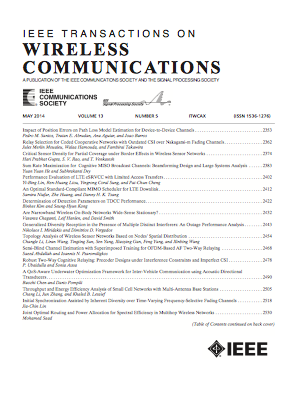安全RIS- enabled ISAC的波束成形设计:被动RIS与主动RIS
IF 10.7
1区 计算机科学
Q1 ENGINEERING, ELECTRICAL & ELECTRONIC
引用次数: 0
摘要
即将到来的第六代(6G)通信标准预计将提供集成传感和通信(ISAC)作为基本服务。这些ISAC系统提出了独特的安全挑战,因为信息信号暴露给传感目标,使他们能够在复杂接收器的帮助下窃听敏感的通信信息。最近,可重构智能表面(RISs)在增强包括ISAC在内的各种无线通信系统的物理层安全性方面显示出了有希望的结果。然而,传统的无源RIS (pRIS)系统的性能经常受到乘法衰落的限制,这可以通过使用有源RIS (aIRS)来缓解。在本文中,我们考虑了一个安全的基于pRIS/ aris的ISAC系统的波束模式增益最大化问题,该系统受到通信接收器的信噪比约束和窃听目标的信息泄漏约束。针对基站与pRIS/aRIS联合波束形成设计中的非凸问题,提出了一种基于连续凸近似(SCA)的新方法。与传统的基于交替优化(AO)的方法不同,本文提出的基于sca的方法在每次迭代中同时更新所有优化变量。与基于处罚的AO方法的基准方案相比,该方法在priss辅助ISAC系统中具有显著的性能优势。此外,我们的仿真结果还证实,在相同的功率预算下,与ris辅助系统相比,ris辅助系统在目标处具有明显更高的波束方向增益。我们还提出了详细的复杂性分析和收敛证明,提出了基于sca的方法。本文章由计算机程序翻译,如有差异,请以英文原文为准。
Beamforming Design for Secure RIS-Enabled ISAC: Passive RIS Versus Active RIS
The forthcoming sixth-generation (6G) communications standard is anticipated to provide integrated sensing and communication (ISAC) as a fundamental service. These ISAC systems present unique security challenges because of the exposure of information-bearing signals to sensing targets, enabling them to potentially eavesdrop on sensitive communication information with the assistance of sophisticated receivers. Recently, reconfigurable intelligent surfaces (RISs) have shown promising results in enhancing the physical layer security of various wireless communication systems, including ISAC. However, the performance of conventional passive RIS (pRIS)-enabled systems are often limited due to multiplicative fading, which can be alleviated using active RIS (aIRS). In this paper, we consider the problem of beampattern gain maximization in a secure pRIS/aRIS-enabled ISAC system, subject to signal-to-interference-plus-noise ratio constraints at communication receivers, and information leakage constraints at an eavesdropping target. For the challenging non-convex problem of joint beamforming design at the base station and the pRIS/aRIS, we propose a novel successive convex approximation (SCA)-based method. Unlike the conventional alternating optimization (AO)-based methods, in the proposed SCA-based approach, all of the optimization variables are updated simultaneously in each iteration. The proposed method shows significant performance superiority for pRIS-aided ISAC system compared to a benchmark scheme using penalty-based AO method. Moreover, our simulation results also confirm that aRIS-aided system has a notably higher beampattern gain at the target compared to that offered by the pRIS-aided system for the same power budget. We also present a detailed complexity analysis and proof of convergence for the proposed SCA-based method.
求助全文
通过发布文献求助,成功后即可免费获取论文全文。
去求助
来源期刊
CiteScore
18.60
自引率
10.60%
发文量
708
审稿时长
5.6 months
期刊介绍:
The IEEE Transactions on Wireless Communications is a prestigious publication that showcases cutting-edge advancements in wireless communications. It welcomes both theoretical and practical contributions in various areas. The scope of the Transactions encompasses a wide range of topics, including modulation and coding, detection and estimation, propagation and channel characterization, and diversity techniques. The journal also emphasizes the physical and link layer communication aspects of network architectures and protocols.
The journal is open to papers on specific topics or non-traditional topics related to specific application areas. This includes simulation tools and methodologies, orthogonal frequency division multiplexing, MIMO systems, and wireless over optical technologies.
Overall, the IEEE Transactions on Wireless Communications serves as a platform for high-quality manuscripts that push the boundaries of wireless communications and contribute to advancements in the field.

 求助内容:
求助内容: 应助结果提醒方式:
应助结果提醒方式:


